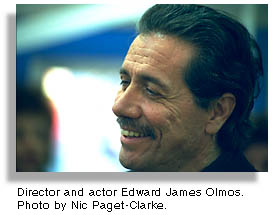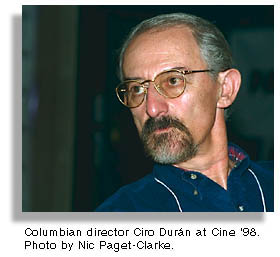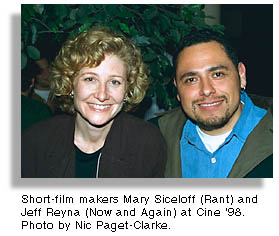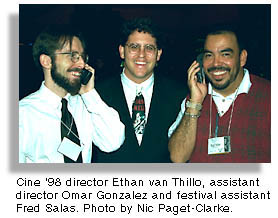| Why does Hollywood produce an average of only one Latino movie per year?
Cine '98 -
A Step Toward Cine Revolución Omar Gonzalez San Diego, California  Also see: Interviews with Moctesuma Esparza, Gabriel Figueroa Flores Jr., and Jorge Cervera, Jr. Also see: Interviews with Moctesuma Esparza, Gabriel Figueroa Flores Jr., and Jorge Cervera, Jr.
Why is it that only a few of the dozens of Latino films produced outside of Hollywood are ever distributed in the United States? Every year great cine is made by Latino filmmakers from all over the U.S. and Latin America. Instead of being screened at your local multi-plex or at the local art house cinema, films sit around collecting dust. Why does Hollywood produce an average of only one Latino movie per year? Latinos average 8.4 annual admissions per movie-goer, well above the averages for whites and African Americans, and lead the way in concession sales at over $2 per person. In addition, Latinos will soon be the largest "minority" group in the nation. What is the problem? Latinos are not a financially viable group in the eyes of media power brokers. The success of Selena and Mi Familia has helped, but changes are slow in coming. The popularity of these two mainstream films demonstrates that we do want to see more films based on our experience on the big screen. Since the majority of Hollywood producers and distributors do not understand the need for more Latino films, we must take action on our own behalf. Cine revolucion! Latino filmmakers such us Luis Valdez, Moctesuma Esparza, Gregory Nava, and Edward James Olmos have opened doors, but more needs to be done. Talented young Latino filmmakers abound, what we need is further access to production and distribution resources. These are resources that will not be given to us, we must fight to create our own opportunities. Olmos has said that, "We as Latinos must produce, market, and distribute our own work and create our own venues; no one else will do that for us." The emergence of Latino film festivals, such as Cine '98 (The San Diego/Baja California Latino Film Festival (1)), is the first step in the process of creating our own distribution venues. We are distributing, albeit on a very small scale, Latino films to our Latino community. In the past five years there has been an explosion of Latino festivals throughout the United States. There are now over fourteen film festivals dedicated to screening films made by or about Latinos. This growth illustrates that Latinos are demanding more venues for their films. The Centro Cultural de La Raza's San Diego/Baja California Latino Film Festival (Cine '98), formerly known as Cine Estudiantil, began four years ago. In those four years over 200 extraordinary Latino student films have been screened at venues throughout San Diego and Baja California to over 5000 people. This year the festival expanded to include feature works by established and emerging Latino filmmakers from Brazil, Colombia, Cuba, Mexico, and the United States. The festival schedule included 15 programs of 9 feature films and 25 shorts, documentaries, and experimental works. Cine '98 was held on March 3-7, 1998 at the United Artists Horton Plaza Theaters in downtown San Diego's historic Gaslamp District. Over 3,000 people attended the five day festival. Every night I would eavesdrop on the conversations of Cine '98 patrons leaving the movie theater. "San Diego really needs an event like this." "That was great!" "Why don't movies like this come out more often?" "It's about time!" The 1998 edition of the San Diego Latino Film Festival was a diverse and exciting event. In addition to all the great films, what made Cine '98 special was the way in which independent filmmakers and industry professionals interacted with the general public. This is what a film festival is all about. On the opening night Moctesuma Esparza screened The Milagro Beanfield War, a film he produced with Robert Redford, and commented on the bright future he sees for Latinos in Hollywood. In the past 25 years Mr. Esparza has produced numerous feature films and television specials, including Selena, The Ballad of Gregorio Cortez, Lorca, The Cisco Kid, and the PBS bilingual children's series Viva Alegre! Currently Moctesuma Esparza and Luis Valdez are developing a film about Cesar Chavez. On the following nights festival attendees saw a variety of films and met several fascinating guests.
Closing night featured the star studded premier of The Wonderful Ice Cream Suit. This film was written by Ray Bradbury and stars Edward James Olmos, Esai Morales, Gregory Sierra, Joe Mantegna, and Clifton Gonzalez-Gonzalez. It was directed by Stuart Gordon. Ice Cream Suit is about five guys from East LA who get together and buy this incredibly bright white suit. On the first night they decide that each one of them will wear the suit for an hour. Wearing the suit transforms each of the characters in a different way. The Wonderful Ice Cream Suit is a very Disney look at the barrio, but it does have a great cast of male Latino actors. It is also the first Disney feature live action film produced to go straight to video. (The Cine '98 screening might have been one of the few chances to see it on the big screen.) It is a fun fairy tale and not much else. Where else will you see Olmos play a goofy bum while Esai Morales sings and dances. Over 600 people came to see the film and hear Edward James Olmos, Clifton Gonzalez-Gonzalez, Ray Bradbury, and Stuart Gordon, talk about this film. Cine '98 is more than a film festival; it is a year round cultural ambassador. Several alternative venues have been established by the festival. There are screenings at San Diego universities and high schools. In Mexico there are events in the border towns of Tijuana and Mexicali. Throughout the year there are also retrospective shows in Mexico City and Morelia, which is in Central Mexico. The San Diego Latino film festival works year round to create venues for under-represented work. In the future there is a plan to have monthly feature screenings in the San Diego area. These steps take us closer toward the creation of year round venues for Latino work. Cine '98 was an incredible festival which showcased a diverse mix of events, people, and work. Support your local festivals and embrace the filmmakers that strive to portray our reality on the big screen. The San Diego Latino Film Festival and events like it take us one step closer toward empowerment and "cine revolucion." "It don't mean a thing if it ain't got that swing." - Duke Ellington Omar Gonzalez was assistant director of the 1998 San Diego/Baja California Latino Film Festival. *(1 ) - The San Diego/Baja California Latino Film Festival was directed by Ethan Van Thillo. Also see: |
| Published in In Motion Magazine May 21, 1998. |
If you have any thoughts on this or would like to contribute to an ongoing discussion in the  What is New? || Affirmative Action || Art Changes || Autonomy: Chiapas - California || Community Images || Education Rights || E-mail, Opinions and Discussion || En español || Essays from Ireland || Global Eyes || Healthcare || Human Rights/Civil Rights || Piri Thomas || Photo of the Week || QA: Interviews || Region || Rural America || Search || Donate || To be notified of new articles || Survey || In Motion Magazine's Store || In Motion Magazine Staff || In Unity Book of Photos || Links Around The World NPC Productions Copyright © 1995-2020 NPC Productions as a compilation. All Rights Reserved. |




